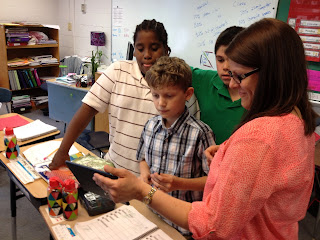After a tour of the academic facilities at ASD, we were fortunate enough to experience direct instruction in three different classrooms that focused on language building through use of Visual Phonics.
At the Kindergarten level, students were focusing on alphabet identification leading into phonemic awareness. The dynamic of this class followed a whole group/individual/whole group model with the teacher using a total communication approach (both sign and spoken English.) Students were asked as a whole group to identify words that began with "w" around the room, then later the students, equipped with individual dry erase boards, were asked to "explore" the classroom and hallway for words that began with the letter "r." Students would write the word and draw a picture that corresponds with the word. After the activity students regrouped and shared their findings. Throughout the instruction and activity, the teacher used Visual Phonics to represent the sounds of focus letters, and practiced sound production using this technique with students.
In the 4th grade classroom we were able to observe a spelling test with the phonemes of each word represented visually as they are auditory represented for any hearing child taking the same test. Again. the instruction was through use of total communication with the assistance of Visual Phonics. We had a lot of fun with this small class of four boys as they corrected their own tests, and found unfortunately in English, rules can be broken and vowel sounds can be spelled multiple ways! The boys showed us their pen pal writing to other schools for the deaf around the country including Wisconsin School for the Deaf.
In a 7th grade classroom students were playing class game is which they would analyze groups of character pictures associated with each Visual Phonics phoneme to produce an English word. Total communication was used for this game.

.jpeg)


.jpeg)
.JPG)